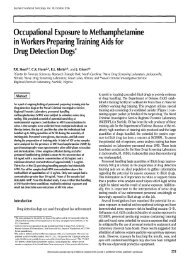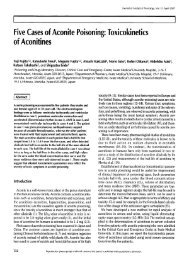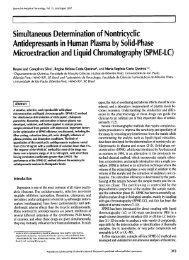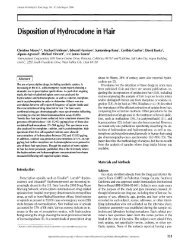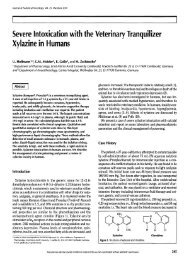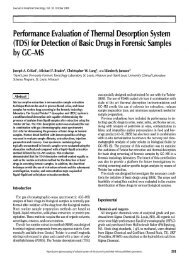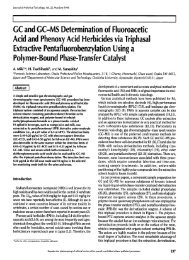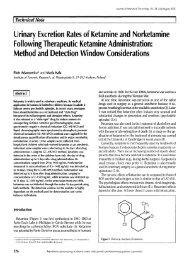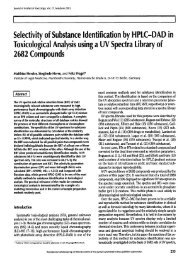Analysis of Buprenorphine, Norbuprenorphine, and Their ...
Analysis of Buprenorphine, Norbuprenorphine, and Their ...
Analysis of Buprenorphine, Norbuprenorphine, and Their ...
You also want an ePaper? Increase the reach of your titles
YUMPU automatically turns print PDFs into web optimized ePapers that Google loves.
Journal <strong>of</strong> Analytical Toxicology, Vol. 27, October 2003<br />
<strong>Analysis</strong> <strong>of</strong> <strong>Buprenorphine</strong>, <strong>Norbuprenorphine</strong>, <strong>and</strong><br />
<strong>Their</strong> Glucuronides in Urine by Liquid<br />
Chromatography-Mass Spectrometry<br />
Robert Kronstr<strong>and</strong>*, Tor G. Selden, <strong>and</strong> Martin Josefsson<br />
National Board <strong>of</strong> Forensic Medicine, Department <strong>of</strong> Forensic Chemistry, University Hospital, 5E-581 85 Link6ping, Sweden<br />
I Abstract<br />
<strong>Buprenorphine</strong> is used for the treatment <strong>of</strong> chronic pain <strong>and</strong> also in<br />
treatment <strong>of</strong> heroin addiction as an alternative to methadone. As<br />
the availability <strong>of</strong> buprenorphine increases, so does the risk for<br />
abuse <strong>and</strong> the pressure on forensic <strong>and</strong> clinical laboratories to<br />
analyze for it. <strong>Buprenorphine</strong> <strong>and</strong> its dealkylated metabolite are<br />
excreted in urine, almost exclusively as glucuronides. The aim <strong>of</strong><br />
the present study was to evaluate electrospray liquid<br />
chromatography t<strong>and</strong>em mass spectrometry (LC-MS-MS) for the<br />
rapid screening <strong>and</strong> quantitation <strong>of</strong> buprenorphine <strong>and</strong> its<br />
metabolites in urine. Three approaches were evaluated: (1) direct<br />
injection <strong>of</strong> diluted urine for measurement <strong>of</strong> glucuronides, (2)<br />
direct injection <strong>of</strong> diluted urine after enzymatic hydrolysis for the<br />
quantitation <strong>of</strong> buprenorphine <strong>and</strong> norbuprenorphine, <strong>and</strong> (3)<br />
quantitation <strong>of</strong> buprenorphine <strong>and</strong> norbuprenorphine after<br />
enzymatic hydrolysis <strong>and</strong> solid-phase extraction (SPE). One<br />
hundred six samples were subjected to procedure 1 <strong>and</strong>, when<br />
positive, fudher quantitated using procedure 2. Only samples with<br />
low analyle concentrations (< 20 pg/L) were subject to SPE.<br />
Concentrations <strong>of</strong> buprenorphine <strong>and</strong> norbuprenorphine in patients<br />
(N = 16) ranged between 31 <strong>and</strong> 1080 pg/L <strong>and</strong> 48-2050 pg/L,<br />
respectively. In suspected abusers (N = 33), the ranges were<br />
2.3-796 pg/L <strong>and</strong> 5.0-2580 pg/L. In four <strong>of</strong> the authentic samples,<br />
both the buprenorphine <strong>and</strong> norbuprenorphine concentrations<br />
were below the 20-pg/L cut<strong>of</strong>f. We concluded that LC-MS-MS<br />
analysis <strong>of</strong> the glucuronides provided an adequate screening<br />
method, but that the direct method for quantitation sometimes had<br />
to be complemented with a concentration by SPE, providing<br />
increased sensitivity, thus lowering the cut<strong>of</strong>f from 20 to 1 pg/L<br />
urine.<br />
Introduction<br />
<strong>Buprenorphine</strong> is an opioid used for the prevention or treat-<br />
ment <strong>of</strong> moderate to severe chronic pain with therapeutic doses<br />
<strong>of</strong> 0.3-0.6 mg in the form <strong>of</strong> sublingual tablets. In some Euro-<br />
pean countries including Sweden, buprenorphine is also used<br />
9 Author to whom correspondence should be addressed. E-mail Robert.Kronstr<strong>and</strong>@rrnv.se.<br />
in treatment <strong>of</strong> heroin addiction as an alternative to metha-<br />
done. The doses are then higher from 1 up to 32 rag/day. In hu-<br />
mans, buprenorphine is metabolized by N-dealkylation to<br />
norbuprenorphine. Both the metabolite <strong>and</strong> the parent drug<br />
undergo extensive conjugation to glucuronides that are ex-<br />
creted in the urine (1). Reported urine concentrations <strong>of</strong> free<br />
buprenorphine are in the low nanogram range (2), <strong>and</strong> thus a<br />
hydrolysis step is recommended before analysis. Feng et al. (3)<br />
reported the quantitative hydrolysis <strong>of</strong> buprenorphine-glu-<br />
curonide (B-3-G) using 13-glucuronidase from E. coil after 2 h<br />
<strong>of</strong> incubation at 37~ <strong>and</strong> at pH 6.8. <strong>Their</strong> study did not include<br />
evaluation <strong>of</strong> the hydrolysis <strong>of</strong> norbuprenorphine-glucuronide<br />
(norB-3-G). However, Lisi et al. (4) optimized the hydrolysis <strong>of</strong><br />
norB-3-G in a urine sample from a volunteer who was admin-<br />
istered 0.2 mg buprenorphine. The hydrolysis required very<br />
high concentrations <strong>of</strong> the enzyme ~-glucuronidase from H.<br />
pomatia, even at a norB-3-G concentration as low as 6 ~g/L.<br />
There are only a few reports on urine concentrations <strong>of</strong><br />
buprenorphine from either drug addicts or patients. Vincent et<br />
al. (5) reported concentrations from 1.0 to 3.3 l=g buprenor-<br />
phine/mg creatinine <strong>and</strong> 0.6-7.0 IJg norbuprenorphine/mg cre-<br />
atinine in five buprenorphine abusers. Tracqui et al. (6) also<br />
reported postmortem urine concentrations <strong>of</strong> 4-1000 IJg/L<br />
(median 196 ~g/L) in 20 fatalities involving buprenorphine.<br />
H<strong>and</strong> et al. (7) reported mean concentrations measured by<br />
radioimmunoassay (RIA) ranging from 16 to 157 pg/L urine in<br />
five patients receiving 0.4-2 rag/day. The authors report that<br />
urinary concentration <strong>of</strong> buprenorphine increased with in-<br />
creased dose, even though there was a marked variation.<br />
Several methods to determine buprenorphine <strong>and</strong> nor-<br />
buprenorphine in biological matrices using detection tech-<br />
niques such as radioimmunoassay (8), electron capture gas<br />
chromatography (GC) (9,10), <strong>and</strong> liquid chromatography (LC)<br />
with electrochemical detection (2,11) have been published.<br />
Also, a variety <strong>of</strong> mass spectrometric (MS) methods have been<br />
published (3,12-17). In recently published methods for thera-<br />
peutic monitoring the detection modes have been t<strong>and</strong>em MS<br />
coupled either to LC (15,17) or GC (14). Postmortem blood con-<br />
centrations have been reported using electrospray LC-MS<br />
(6,18). Polettini et al. (17) measured not only buprenorphine<br />
464 Reproduction (photocopying) <strong>of</strong> editorial content <strong>of</strong> this journal is prohibited without publisher's permission.
Journal <strong>of</strong> Analytical Toxicology, Vol. 27, October 2003<br />
<strong>and</strong> norbuprenorphine, but also B-3-G in plasma samples using<br />
LC-MS--M8. The methods for urine, though, have all been di-<br />
rected towards the free (or liberated) analytes using either<br />
GC-MS with electron impact ionization (3,5) or LC-MS with<br />
electrospray (13).<br />
The aim <strong>of</strong> the present study was to evaluate electrospray<br />
LC-MS-MS for the rapid screening <strong>and</strong> quantitation <strong>of</strong><br />
buprenorphine <strong>and</strong> its metabolites in urine. Three approaches<br />
<strong>and</strong> combinations <strong>of</strong> these were evaluated: (1) direct injection<br />
<strong>of</strong> diluted urine for measurement <strong>of</strong> glucuronides, (2) direct in-<br />
jection <strong>of</strong> diluted urine after enzymatic hydrolysis for the quan-<br />
titation <strong>of</strong> buprenorphine <strong>and</strong> norbuprenorphine, <strong>and</strong> (3)<br />
quantitation <strong>of</strong> buprenorphine <strong>and</strong> norbuprenorphine after en-<br />
zyrnatic hydrolysis <strong>and</strong> solid-phase extraction (SPE).<br />
Materials <strong>and</strong> Methods<br />
Chemicals <strong>and</strong> reagents<br />
The reference materials buprenorphine, norbuprenorphine,<br />
buprenorphine-d4, <strong>and</strong> norbuprenorphine-d3 where purchased<br />
from Cerilliant (Austin, TX). B-3-G <strong>and</strong> norB-3-G were iso-<br />
lated from urine by collection <strong>of</strong> high-performance LC fractions<br />
around the retention time for each analyte. The eluates were<br />
used to optimize the MS-MS parameters by direct infusion.<br />
[~-Glucuronidase (E. coli, 200 U/mL) was purchased from Roche<br />
(Mannheim, Germany). Millipore Ultrafree MC 0.22-1~m filters<br />
were purchased from Millipore AB (Sundbyberg, Sweden). All<br />
inorganic chemicals were <strong>of</strong> analytical grade, <strong>and</strong> all organic<br />
solvents were <strong>of</strong> gradient or analytical grade.<br />
Instrumentation<br />
The LC--MS-MS analysis was performed on a PerkinElmer<br />
series 200 chromatography system consisting <strong>of</strong> two 200 micro-<br />
pumps, a "hot-pocket" column oven, a 200 autosampler, <strong>and</strong> a<br />
SCIEX API 2000 MS-MS instrument (Applied Biosystems,<br />
Table I. Retention Times, Transitions, <strong>and</strong> MS-MS<br />
Parameters for Each Analyte <strong>and</strong> Internal St<strong>and</strong>ard*<br />
Transition<br />
(m/z) DP CE CXP<br />
Rt (Q1) (Q2)(Q2)<br />
Analyte (min) Q1 Q3 (V) (V) (V)<br />
468.4 100 5 23<br />
<strong>Buprenorphine</strong> 4.20 468.4 414.2 100 45 21<br />
396.3 100 50 10<br />
414.1 80 5 15<br />
<strong>Norbuprenorphine</strong> 3.05 414.1 101.2 80 55 18<br />
644.4 100 5 35<br />
B-3-G 2.73 644.4 468.1 100 53 20<br />
590.1 110 5 30<br />
NorB-3-G 1.71 590.1 414.2 110 50 20<br />
<strong>Buprenorphine</strong>-d 4 4.17 472.3 472.3 100 5 23<br />
<strong>Norbuprenorphine</strong>..d 3 3.03 417.2 417.2 80 5 21<br />
* Focusing potential, entrance potential, <strong>and</strong> dwell times were 350 V, 11 V,<br />
<strong>and</strong> 100 ms, respectively, for all transitions. DP = declustering potential,<br />
CE = collision energy, <strong>and</strong> CXP = collision cell exit potential.<br />
Toronto, ON, Canada) equipped with an electrospray interface<br />
(TIS). Ion spray voltage was set to 5000 V. Nitrogen was used as<br />
nebulizer gas (25 psi), auxiliary gas (50 psi heated to 3000C),<br />
curtain gas (30 psi), <strong>and</strong> as collision-activated dissociation gas<br />
(set on 5). A 50- 2.l-ram Zorbax phenyl analytical column<br />
with 3.5-pro particle size (Agilent Technologies, Kista, Sweden)<br />
was used. Mobile phase A was a 10:10:80 mixture <strong>of</strong> acetoni-<br />
trile/methanol/20mM ammonium formate buffer (pH 3.0), <strong>and</strong><br />
mobile phase B was a 35:35:30 mixture. The system was run in<br />
a linear gradient from 75% A-phase to 10% A-phase during 5<br />
rain, followed by a l-rain equilibration with 90% A-phase. The<br />
total flow rate was 0.25 mlJmin. The column oven was set at<br />
30~ A 10-1~L aliquot <strong>of</strong> the samples was injected. Chro-<br />
matograms were evaluated with Analyst v. 1.2 s<strong>of</strong>tware. The<br />
mass spectrometric details <strong>of</strong> the method are listed in Table I.<br />
Samples<br />
Urine samples from 16 patients receiving Subutex | in a<br />
detoxification program were sent to our laboratory for<br />
buprenorphine analysis. Urine samples from 106 cases sent to<br />
our laboratory from the Swedish police or a Swedish prison <strong>and</strong><br />
probation services, where buprenorphine was requested, were<br />
also analyzed. Urine samples from patients <strong>and</strong> authentic cases<br />
were collected in plastic tubes without any preservative, shipped<br />
to the laboratory, <strong>and</strong> stored at 4~ until analyzed. The urine<br />
creatinine concentration was determined with the Jaffg method<br />
on an Advia 1650 from Bayer AB (Gothenburg, Sweden).<br />
Analytical procedures<br />
Direct analysis <strong>of</strong> glucuronides <strong>and</strong> free buprenorphine<br />
<strong>and</strong> norbuprenorphine. Aliquots <strong>of</strong> the urine samples were<br />
centrifuged through 0.22-pro filters, <strong>and</strong> 100 pL <strong>of</strong> the<br />
filtrate was transferred to a vial prepared with 25 pL internal<br />
st<strong>and</strong>ard (buprenorphine-d4/norbuprenophine-d3, 0.4<br />
lJg/mL). One hundred microliters <strong>of</strong> mobile phase buffer<br />
(20mM ammonium formate buffer, pH 3.0) was added. The<br />
vials were then capped <strong>and</strong> mixed. A 10-11L aliquot was<br />
injected.<br />
Ouantitation <strong>of</strong> buprenorphine <strong>and</strong> norbuprenorphine after<br />
enzymatic hydrolysis. One milliliter <strong>of</strong> the urine samples was<br />
transferred to a 10-mL glass tube. 'l~venty-five microliters <strong>of</strong> in-<br />
ternal st<strong>and</strong>ard (buprenorphine-d4/norbuprenorphine-d3, 4.0<br />
pg/mL), 300 pL 0.5M BIS-TRIS propane buffer (pH 6.8), <strong>and</strong> 40<br />
pL [3-glucuronidase were added. The tubes were capped <strong>and</strong> in-<br />
cubated in a water bath (with orbital shaking) at 37~ for 20 h.<br />
An aliquot <strong>of</strong> the samples were then centrifuged through the<br />
0.22-pm filter, <strong>and</strong> 100 pL <strong>of</strong> the supernatant was subsequently<br />
transferred to a vial. A 10-pL aliquot was injected.<br />
Together with the authentic samples controls at 20 <strong>and</strong> 200<br />
pg/L, a hydrolysis control composed <strong>of</strong> pooled samples diluted<br />
to a concentration <strong>of</strong> approximately 100 pg/L <strong>of</strong> the glu-<br />
curonides were analyzed.<br />
Quantitation <strong>of</strong> buprenorphine <strong>and</strong> norbuprenorphine after<br />
enzymatic hydrolysis <strong>and</strong> SPE. Hydrolysis <strong>of</strong> 1.0 mL urine<br />
was performed as described previously, <strong>and</strong> the pH was then ad-<br />
justed to 6.1 with 4 mL <strong>of</strong> 0.2M phosphate buffer. SPE was<br />
performed as described by Vincent et al. (5), but with lower sol-<br />
vent volumes in the wash steps because only half the sample<br />
465
volume was used. BondElute Certify columns were activated<br />
<strong>and</strong> conditioned with 2 mL <strong>of</strong> methanol followed by 2 mL <strong>of</strong><br />
0.2M phosphate buffer (pH 6.1). The sample was drawn through<br />
the column, which was then rinsed with 2 mL <strong>of</strong> deionized<br />
water, 2 mL <strong>of</strong> 0.1M HCI, <strong>and</strong> 2 mL <strong>of</strong> methanol. The column<br />
then was dried for 5 rain (10 in. Hg), <strong>and</strong> the analytes were<br />
eluted with 2 mL <strong>of</strong> a mixture <strong>of</strong> dichloromethane/2-propanol<br />
(80:20) containing 2% ammonia (25%). The eluate was evapo-<br />
rated in a TurboVap at 40~ <strong>and</strong> 5 psi nitrogen. The residue was<br />
reconstituted in 100 lJL <strong>of</strong> mobile phase A. A 10-laL aliquot<br />
was injected.<br />
Retention times <strong>and</strong> measured transitions for each analyte<br />
are listed in Table I. MS--MS parameters for each analyte were<br />
optimized by infusion <strong>of</strong> st<strong>and</strong>ards dissolved in mobile phase.<br />
Calibration curves were performed by addition <strong>of</strong> st<strong>and</strong>ard so-<br />
lutions to 5-mL batches <strong>of</strong> negative urine. From the batches,<br />
1.0 mL was pipetted for each calibration level, <strong>and</strong> the calibra-<br />
tors were treated as authentic samples. Calibrations were per-<br />
formed in duplicates. Final calibrator concentrations for the<br />
direct injection methods were 10, 25, 50, 100, 250, 500, <strong>and</strong><br />
1000 ljg/L for buprenorphine <strong>and</strong> norbuprenorphine. For the<br />
SPE method, the calibrator concentrations were at 1.0, 5.0,<br />
10, 25, <strong>and</strong> 50 lag/t,.<br />
Method validation<br />
The hydrolysis step was performed with 13-glucuronidase<br />
from B. coli as proposed by Feng et al. (3). The efficiency for<br />
norB-3-G hydrolysis was tested with different amounts <strong>of</strong> en-<br />
zyme (40-120 laL) <strong>and</strong> at different incubation times from 0.5 to<br />
24 h at pH 6.8 as proposed by Feng et al. (3), as well as the man-<br />
ufacturer <strong>of</strong> the enzyme.<br />
The sensitivity for the screening method was estimated by<br />
correlating the peak areas for the glucuronides before hydroly-<br />
sis to the concentrations <strong>of</strong> the free analyte after hydrolysis (in<br />
the 16 patient samples). In this way, equations describing the<br />
466<br />
Int~lty<br />
2.13<br />
*~IRM PA4.4~44 4 16~0 I<br />
o<br />
Inllmlll<br />
171<br />
2,73 1.71<br />
'~RM $90 ltSgO 1<br />
20 30 40 SO<br />
320<br />
r Id ~44.4,~468.1 *~4~ M SgO 1~414~<br />
200<br />
100<br />
.. ~.A ......... A<br />
Time (mbl) Tlrrle (mln)<br />
Figure 1. Ion chromatograms from direct injection <strong>of</strong> the hydrolysis<br />
control before hydrolysis. B-3-G transitions are m/z 6441644 <strong>and</strong><br />
644/46B, <strong>and</strong> norB-3-G transitions are 590/590 <strong>and</strong> 590/414.<br />
Journal <strong>of</strong> Analytical Toxicology, Vol. 27, October 2003<br />
relationship between B-3-G <strong>and</strong> buprenorphine (y = 173,055x<br />
- 868, r = 0.99) <strong>and</strong> norB-3-G <strong>and</strong> norbuprenorphine (.g =<br />
113,000x - 1793, r = 0.99) were obtained. The point where the<br />
regression line crosses the x-axis (y = 0) could be an estimate<br />
<strong>of</strong> the thresholds for B-3-G <strong>and</strong> norB-3-G.<br />
LOQ was considered the concentration where the coefficient<br />
<strong>of</strong> variation was lower than 15% (N = 5).<br />
The within-day <strong>and</strong> between-day imprecisions for the direct<br />
method were estimated by analysis <strong>of</strong> control samples at 20 <strong>and</strong><br />
200 lag/L, as well as a hydrolysis control (authentic sample) in<br />
the same batch (iV = 5) <strong>and</strong> on different days over a period <strong>of</strong><br />
two months (N = 10).<br />
Extraction recovery for the SPE method was estimated by<br />
comparing peak areas from extracted st<strong>and</strong>ards (N = 5) at 1.0<br />
<strong>and</strong> 10.0 lag/L with those from st<strong>and</strong>ards prepared directly in<br />
mobile phase A. Within-day imprecision was estimated by anal-<br />
ysis <strong>of</strong> 5 control samples at 1.0 <strong>and</strong> 10 IJg/L.<br />
Results<br />
Linear calibration curves were established for both the direct<br />
<strong>and</strong> SPE methods. For the direct method, equations were y =<br />
0.990x + 0.0540 (r = 0.999) for buprenorphine <strong>and</strong> y = 0.701x<br />
+ 0.0381 (r = 0.999) for norbuprenorphine. For the SPE<br />
method, the equations were y = 0.890x- 0.0024 (r = 0.999) for<br />
buprenorphine <strong>and</strong> y = 0.77~ + 0.0004 (r = 0.998) for nor-<br />
buprenorphine. Chromatograms from the analysis <strong>of</strong> the hy-<br />
drolysis control are shown in Figures I <strong>and</strong> 2. Chromatograms<br />
from a positive sample containing low concentrations <strong>of</strong><br />
buprenorphine <strong>and</strong> norbuprenorphine are shown in Figures<br />
3-5. The estimated thresholds for B-3-G <strong>and</strong> norB-3-G were<br />
5 <strong>and</strong> 16 ]Jg/L, respectively. These were also confirmed by re-<br />
suits from authentic samples (see Figure 3). The hydrolysis <strong>of</strong><br />
norbuprenorphine at different enzyme concentrations is shown<br />
in Figure 6. Imprecision data for the two quantitation methods<br />
are shown in Tables II <strong>and</strong> III. The extraction recoveries <strong>of</strong> the<br />
SPE method were 84% <strong>and</strong> 98% for buprenorphine at 1.0 <strong>and</strong><br />
10.0 IJg/L, respectively. For norbuprenorphine, the recoveries<br />
were 77% <strong>and</strong> 91% at 1.0 <strong>and</strong> 10.0 lag/L, respectively. The rel-<br />
ative intensities for the product ion transitions compared with<br />
the molecular ion was 1.4% <strong>and</strong> 1.6% for transitions rn/z<br />
468/414 <strong>and</strong> 468/396, whereas for norbuprenorphine the tran-<br />
sition m/z 414/101 showed a 3.4% intensity. Even though the<br />
molecular ions showed prominent peaks well below 20 lag/L<br />
LOQ for the direct method <strong>and</strong> the one <strong>of</strong> 1 lag/L for the SPE<br />
method, they were limited by the criteria to have visible peaks<br />
for the respective product ions.<br />
As urine samples were analyzed both before <strong>and</strong> after hy-<br />
drolysis, the concentration <strong>of</strong> unconjugated buprenorphine<br />
<strong>and</strong> norbuprenorphine was measured. Four patients had con-<br />
centrations <strong>of</strong> free buprenorphine above the 20-~g/L cut<strong>of</strong>f,<br />
whereas all but two had higher concentrations <strong>of</strong> free nor-<br />
buprenorphine. Urine concentrations <strong>of</strong> buprenorphine <strong>and</strong><br />
norbuprenorphine from patients are shown in Table IV, <strong>and</strong><br />
concentrations in urine samples from authentic cases are<br />
shown in Table V. For samples that had concentrations <strong>of</strong> either
Journal <strong>of</strong> Analytical Toxicology, Vol. 27, October 2003<br />
buprenorphine or norbuprenorphine lower than 20 IJg/L, the<br />
quantitation results from the SPE method are also included.<br />
Discussion<br />
The approach to determine the glucuronides both in the di-<br />
rect injection, as well as after hydrolysis, gives the unique op-<br />
portunity to evaluate the efficiency <strong>of</strong> the hydrolysis step in<br />
each <strong>and</strong> every sample. Thus, a traditional hydrolysis control is<br />
not <strong>of</strong> paramount importance. The hydrolysis <strong>of</strong> norB-3-G<br />
showed a much slower rate than B-3-G (Figure 6), which may<br />
be important when measuring ratios <strong>of</strong> the parent to metabo-<br />
lite, as one tends to overestimate the ratio if the hydrolysis is in-<br />
12+001<br />
ICO<br />
4~0<br />
IUO0<br />
10,000<br />
0<br />
i, mm, ly<br />
I+0 2.0<br />
Z33<br />
*MRMe44.~4<br />
3J) 40 5.0<br />
1.0 2.0 I0 4.0 ~+0<br />
+M RM 4~4/414L2 I 9 I<br />
,MRM 4"/2~4"/2~<br />
1,10<br />
I0 2O I~ 4O &O<br />
Time (mln)<br />
120<br />
I0<br />
40<br />
0<br />
12.0~<br />
o<br />
lo,o~<br />
Ir~n~l<br />
*MRM 81~ U~0.1<br />
1.0 2.0 10 4O II.0<br />
*MflM 4t4.U~(1<br />
10 20 &0 4.11 SO<br />
1.0 ~0 ~0 ~0 ~0<br />
0 11) " 2.0 ]~I 4~I ILO<br />
(mln)<br />
Figure 2. Ion chromatograms from direct injection <strong>of</strong> the hydrolysis<br />
control after enzymatic hydrolysis. B-3-G transition 6441644 is shown to-<br />
gether with 468/468 <strong>and</strong> 468/414 for buprenorphine <strong>and</strong> m/z 472/472<br />
for the internal st<strong>and</strong>ard bupmnorphine-d4, norB-3-G transition 590/590<br />
is shown together with 414/414 <strong>and</strong> 414/101 for norbuprenorphine <strong>and</strong><br />
m/z 417/417 for the internal st<strong>and</strong>ard norbuprenorphine-d 3. There are no<br />
peaks at the retention times for norB-3-G (I .71 min) <strong>and</strong> B-3-G (2.73<br />
min), indicating complete hydrolysis.<br />
Int*n~y<br />
2.75<br />
1JO 2.O 3.O 4.0 S J0<br />
2.73<br />
~ M 844.4/4M.I<br />
1 [11 AI<br />
2.0 3~ 4.0 5.0<br />
Time (m~)<br />
Inten~<br />
200<br />
t00<br />
20<br />
o ~j 1~ 2~ 3.0 4.0 S~<br />
1.79<br />
el~i~M~)0.1~142<br />
lli<br />
2.0 3~ 4.0 $.0<br />
Tim (mln)<br />
Figure 3. Ion chromatograms from direct injection <strong>of</strong> sample 4 before hy-<br />
drolysis. B-3-G transitions are nl/z 644/644 <strong>and</strong> 644/468, <strong>and</strong> norB-3-G<br />
transitions are 590/590 <strong>and</strong> 590/414.<br />
m<br />
Int*~ 4.24<br />
,41RM 4~L4/4~4<br />
1 1 r<br />
1.0 ~0 ~ 4.0<br />
*II~441B.4~142<br />
4,24<br />
1.0<br />
A. A<br />
1.0 2.0 ~LO 4.0 IkO<br />
14TZ.~<br />
I n ~ 5.0t<br />
I1 .<br />
r 414.1M14.1<br />
7.TO<br />
1.0 2.0 3.0 4.0 &O<br />
AAI ILl ulli<br />
1.0 2.O ~0 4.0 6.O<br />
ii<br />
0 110 &O 4.O LO tO 2-O 3.O 4.O LO<br />
~m* (ram) "rim* (nW)<br />
Figure 4. Ion chromatograms from direct injection <strong>of</strong> sample 4 after en-<br />
zymatic hydrolysis. Transitions m/z 468/468 <strong>and</strong> 468/414 for buprenor-<br />
phine are shown together with m/z 472/472 for the internal st<strong>and</strong>ard<br />
buprenorphine-d4. Transitions m/z 414/414 <strong>and</strong> 414/101 for nor-<br />
buprenorphine are shown together with m/z 417/417 for the internal<br />
st<strong>and</strong>ard norbupmnorphine-d 3.<br />
467
complete. This phenomenon is well known for the hydrolysis <strong>of</strong><br />
the glucuronides <strong>of</strong> morphine <strong>and</strong> codeine (19). Increasing the<br />
amount <strong>of</strong> enzyme in the incubation mixture did improve the<br />
recovery <strong>of</strong> norbuprenorphine, but because the difference was<br />
less than 15%, we chose to use the lowest amount <strong>of</strong> enzyme.<br />
Because <strong>of</strong> the direct injection, it was more important to min-<br />
imize the amount <strong>of</strong> possible interferences in the sample. Even<br />
though the hydrolysis may not be complete, the repeated anal-<br />
ysis <strong>of</strong> an authentic sample over 2 months showed a variation <strong>of</strong><br />
less than 8% (see Table III).<br />
The detection <strong>of</strong> glucuronides also adds another dimension to<br />
identification. Josefsson et al. stated that working with LC-MS<br />
one can choose to measure several analytes to confirm the in-<br />
take <strong>of</strong> a drug instead <strong>of</strong> measuring several ions (or transi-<br />
tions) for just one analyte (20). This is especially worthwhile for<br />
substances in which the fragmentation is limited.<br />
Some <strong>of</strong> the published methods for buprenorphine deal with<br />
the difficulties in obtaining adequate fragmentation for<br />
LC-MS--MS (15,17). The molecular ions <strong>of</strong> both buprenorphine<br />
<strong>and</strong> norbuprenorphine are readily formed, but seem very stable<br />
under varying conditions in the collision cell. This may be be-<br />
cause <strong>of</strong> the complex ring structure that is able to accommodate<br />
tn~<br />
*14nM 4et4/~4<br />
to zo 3o *.o 5.0<br />
201 ..Mf~1488.4/4142<br />
4~<br />
1,<br />
10 2.0 3o 4~ 5.0<br />
4~<br />
A<br />
1.0 20 3,0" 4.0 so I<br />
Tmle (rnln)<br />
Immr, mt~<br />
1~0 ~414 1/414,1<br />
6,000<br />
0<br />
;.0o<br />
2.m<br />
1.0 ~.0 )0 4.0 s.O<br />
2M<br />
0 I uJiJm ~mu~, ~ A ~ II<br />
l.O 2.0 30 4.0 SO<br />
.IA4qM 41 Y~T/417.2<br />
tO 2.O 1.0 4.O 5.0<br />
Time (mini<br />
Figure 5. Ion chromatograms from sample 4 after enzymatic hydrolysis<br />
<strong>and</strong> SPE. Transitions m/z 468/468 <strong>and</strong> 468/414 for buprenorphine are<br />
shown together with m/z 472/472 for the internal st<strong>and</strong>ard buprenor-<br />
phine-d4. Transitions m/z 414/414 <strong>and</strong> 414/101 for norbuprenorphine are<br />
shown together with m/z 417/417 for the internal st<strong>and</strong>ard nor-<br />
buprenorphine-d3. Concentrations <strong>of</strong> buprenorphine <strong>and</strong> norbuprenor-<br />
phine are 8.1 <strong>and</strong> 5.0 pg/L, respectively. After SPE, the peak intensities<br />
were approximately 10 times as high as those from direct injection (see<br />
Figure 4).<br />
468<br />
Journal <strong>of</strong> Analytical Toxicology, Vol. 27, October 2003<br />
the excitation energy to a point where the molecule literally<br />
shatters with no significant high mass fragment ions surviving.<br />
Polettini <strong>and</strong> Huestis (17) overcame that problem by using the<br />
parent ion for quantitation, in other words letting the molecular<br />
ion pass through the mass filters to the detector as in single MS<br />
mode. Moody et al. (15), however, achieved a 20% abundance <strong>of</strong><br />
the rn/z 396 product ion providing sufficient sensitivity to an-<br />
alyze subnanogram buprenorphine concentrations in plasma<br />
samples using multiple-reaction monitoring (MRM) (15). The<br />
experiments in these two reports were performed on differ-<br />
ently designed triple-quadrupole instruments with unique col-<br />
lision cells using different collision gases (nitrogen or argon).<br />
The use <strong>of</strong> the heavier argon as collision gas might account for<br />
the more pronounced fragmentation achieved by Moody et al.<br />
(15). In our applications, however, a LINAC TM collision cell <strong>and</strong><br />
nitrogen gas were used. As did Polettini <strong>and</strong> Huestis (17), we<br />
1110<br />
140<br />
A<br />
0 g<br />
B<br />
10 111 20 2S<br />
'tim (h)<br />
I% 10 16 20 28<br />
Time {h)<br />
Figure 6. <strong>Buprenorphine</strong> (A) <strong>and</strong> norbuprenorphine (B) concentrations<br />
after hydrolysis with different amounts <strong>of</strong> ~-glucuronidase. Incubation in<br />
a waterbath with orbital shaking at 37~ (u) 40 pL enzyme, (n) 80 pL en-<br />
zyme, <strong>and</strong> (A) 120 pL enzyme.<br />
Table II. Within-Day Imprecision for the Quantitation<br />
Methods (N = 5)<br />
AddedConc. Mean Accuracy CV<br />
Analyte (pg/L) (pg/L) (%) (%)<br />
Controls (SPE method)<br />
<strong>Buprenorphine</strong> 1 1.16 116 9.5<br />
<strong>Buprenorphine</strong> 10 10.4 104 2.1<br />
<strong>Norbuprenorphine</strong> I 1.23 123 13.3<br />
<strong>Norbuprenorphine</strong> I0 10.7 107 9.4<br />
Controls (direct method)<br />
<strong>Buprenorphine</strong> 20 18.8 94 1.9<br />
<strong>Buprenorphine</strong> 200 191 96 3.2<br />
<strong>Norbuprenorphine</strong> 20 22.2 111 5.0<br />
<strong>Norbuprenorphine</strong> 200 222 111 6.5<br />
Authentic sample (direct method)<br />
<strong>Buprenorphine</strong> - 93.1 - 4.0<br />
<strong>Norbuprenorphine</strong> - 146 - 3.6
Journal <strong>of</strong> Analytical Toxicology, Vol. 27, October 2003<br />
used the surviving parent ion for buprenorphine, nor-<br />
buprenorphine, <strong>and</strong> their internal st<strong>and</strong>ards for quantitation,<br />
but also measured the transitions for one or two product ions<br />
to strengthen the identity. However, the relative intensities<br />
compared with the molecular ion were only a few percent. The<br />
glucuronides, though, showed prominent fragmentation caused<br />
by deconjugation, as can be seen in Figure 1.<br />
Concentrations in patients <strong>and</strong> abusers showed a considerable<br />
overlap, but no patients had lower concentrations than 30 pg/L,<br />
whereas some abusers showed as low as 2.3 pg/L <strong>of</strong> buprenor-<br />
phine. H<strong>and</strong> et al. (6) also reported such low concentrations in<br />
abusers at a drug clinic. Forty-three <strong>of</strong> their 60 positive cases<br />
had concentrations lower than 25 pg/L (measured with RIA).<br />
These <strong>and</strong> our low concentrations probably reflect buprenor-<br />
phine administration several days before sampling. Vincent et al.<br />
(5) reported urinary concentrations higher than 20 pg/L, even<br />
after three days <strong>of</strong> abstinence. Tracqui et al. (6) reported<br />
buprenorphine concentrations <strong>of</strong> 4-1033 pg/L in 20 fatalities at-<br />
Table III. Between-Day Imprecision for the Quantitation<br />
by Direct Injection (N = 10)<br />
Added Conc. Mean Accuracy CV<br />
Analyte (pg/L) (pg/L) (%) (%)<br />
Controls<br />
<strong>Buprenorphine</strong><br />
<strong>Buprenorphine</strong><br />
<strong>Norbuprenorphine</strong><br />
<strong>Norbuprenorphine</strong><br />
Authentic sample<br />
<strong>Buprenorphine</strong><br />
<strong>Norbuprenorphine</strong><br />
20 20,1 100.8 7.3<br />
200 198 99.0 6.2<br />
20 21.7 108.6 6.8<br />
200 201 100.5 7.5<br />
96.3 - 7.6<br />
146 - 6.2<br />
Table IV. Urine Concentrations <strong>of</strong> <strong>Buprenorphine</strong> <strong>and</strong><br />
<strong>Norbuprenorphine</strong>, Daily Dose, <strong>and</strong> Creatinine<br />
Concentrations from 16 Patients Under Ongoing Subutex<br />
Treatment for Heroin Dependence<br />
Daily BUP/ NorBUP/<br />
BUP NorBUP Dose Crealinine Creatinine Creatinine<br />
Patient (IJg/C) (pg/C) (mg) (g/L) (pg/g) (pg/g)<br />
1 36 48 1 0.6 60 80<br />
2 40 142 6 0.5 80 284<br />
3 174 690 8 1.7 102 406<br />
4 543 1510 8 2.8 194 539<br />
5 87 473 10 0.7 124 676<br />
6 52 274 12 0.5 104 548<br />
7 61 60 12 0.8 76 75<br />
8 538 2050 12 2.4 224 854<br />
9 72 559 12 0.9 80 621<br />
10 222 611 14 1.6 139 382<br />
11 537 1020 14 2.1 256 486<br />
12 45 265 16 0.6 75 442<br />
13 35 204 16 0.6 58 340<br />
14 31 116 16 0.2 155 580<br />
15 433 646 24 0.5 866 1290<br />
16 1080 1700 32 1.5 720 1130<br />
tributed to buprenorphine overdose. Because concentrations in<br />
urine were high, one cannot rule out residual buprenorphine<br />
concentrations as an acute overdose well might leave a negative<br />
urine sample. In approximately 10% <strong>of</strong> our cases, both the<br />
buprenorphine <strong>and</strong> norbuprenorphine concentrations were<br />
below the 20-pg/L cut<strong>of</strong>f. This threshold seems appropriate for<br />
testing <strong>of</strong> patients, but the direct quantitation method may<br />
suffer from low sensitivity.<br />
Thus, in cases in which the peaks for B-3-G or norB-3-G are<br />
very small, one should consider to proceed with the more sen-<br />
sitive SPE method instead <strong>of</strong> injecting the diluted urine. This<br />
could then be a suitable combination for general drug screen,<br />
as it could detect buprenorphine abuse several days after last<br />
use.<br />
The possibility <strong>of</strong> LC-MS--MS to inject samples without pre-<br />
treatment or time-consuming extractions is very tempting, but<br />
although MRM analysis with compound-specific transitions al-<br />
Table V. Urine Concentrations <strong>of</strong> <strong>Buprenorphine</strong>,<br />
<strong>Norbuprenorphine</strong>, <strong>and</strong> Creatinine in Authentic Samples<br />
for which Auprenorphine <strong>Analysis</strong> had been Requested<br />
<strong>and</strong> Screened Positive for the Glucuronides*<br />
Direct Method 5PE Method<br />
Sample BUP NorBUP BUP NorBUP Creatinine<br />
no. (pg/L) (pg/C) (pg/C) (pg/C) (g/L)<br />
1 2.9 4.8 2.3 7.3 1.2<br />
2 4.9 17.4 5.7 9.5 0.9<br />
3 5.0 40.t 5.1 32.5 0.6<br />
4 7.6 7.8 8.1 5.0 1.4<br />
5 9.2 35.4 7.7 24.2 0.2<br />
6 9.5 16.9 7.9 12.9 1.6<br />
7 9.9 29.0 8.8 25.1 0.5<br />
8 11.4 27.2 5.3 20.3 0.8<br />
9 21.1 107 1.2<br />
10 23.6 41.4 1.9<br />
11 30.0 78.8 1.2<br />
12 32.1 72.6 110<br />
13 40.7 69.4 2.6<br />
14 41.0 129 1.4<br />
15 55.3 221 1.8<br />
16 56.3 64.6 2.2<br />
17 77.7 21.2 1.5<br />
18 83.5 114 1.1<br />
19 138 287 2.4<br />
20 148 447 2.2<br />
21 151 410 0.5<br />
22 169 333 1.0<br />
23 215 232 0.7<br />
24 218 33.3 2.6<br />
25 295 1620 2.5<br />
26 321 766 0.9<br />
27 349 35.8 1.9<br />
28 365 48.7 3.6<br />
29 410 352 0.6<br />
30 457 2580 2.4<br />
31 501 65.4 3.2<br />
32 650 180 0.6<br />
33 796 212 1.2<br />
469
lows accurate determinations at very low concentrations, there<br />
is a risk for ion suppression in the ES interface causing re-<br />
duced analyte ionization. In urine analysis, this is especially true<br />
for less retained polar analytes such as the glucuronides because<br />
polar components <strong>and</strong> salts in the matrices might coelute.<br />
However, with SPE sample preparation, most <strong>of</strong> these compo-<br />
nents can be eliminated <strong>and</strong> the analytes concentrated.<br />
Conclusions<br />
We conclude that the methods presented can be used for<br />
screening <strong>and</strong> quantitation <strong>of</strong> buprenorphine <strong>and</strong> its metabo-<br />
lites in urine. The direct injection <strong>of</strong> diluted urine <strong>and</strong> mea-<br />
surement <strong>of</strong> conjugates with LC-MS--MS serves as a rapid <strong>and</strong><br />
reliable procedure that can be followed by the hydrolysis <strong>of</strong> a<br />
new aliquot <strong>of</strong> urine. Depending on the results from the<br />
screening, either a direct quantitation by injection <strong>of</strong> the diluted<br />
hydrolysate or a further concentration <strong>of</strong> the sample by SPE can<br />
be performed.<br />
References<br />
1. E.J. Cone, C.W. Gorodetzky, D. Yousefnejad, W.F. Buchwald, <strong>and</strong><br />
R.E. Johnson. The metabolism <strong>and</strong> excretion <strong>of</strong> buprenorphine in<br />
humans. Drug Metab. Dispos. 12:577-581 (1984).<br />
2. L. Debrab<strong>and</strong>ere, M. Van Boven, <strong>and</strong> P. Daenens. <strong>Analysis</strong> <strong>of</strong><br />
buprenorphine in urine specimens. J. Forensic Sci. 37:82-89<br />
(1991).<br />
3. S. Feng, M.A. EISohly, <strong>and</strong> D.T. Duckworth. Hydrolysis <strong>of</strong> conju-<br />
gated metabolites <strong>of</strong> buprenorphine. I. The quantitative enzymatic<br />
hydrolysis <strong>of</strong> buprenorphine-3-[3-D-glucuronide in human urine.<br />
J. Anal. Toxicol. 25:589-593 (2001).<br />
4. A.M. Lisi, R. Kazlauskas, <strong>and</strong> G.J. Trout. Gas chromatographic-mass<br />
spectrometric quantitation <strong>of</strong> urinary buprenorphine <strong>and</strong> nor-<br />
buprenorphine after derivatization by direct extractive alkylation.<br />
J. Chromatogr. B 692:67-77 (1997).<br />
5. F. Vincent, J. Bessard, J. Vacheron, M. Mallaret, <strong>and</strong> G. Bessard. De-<br />
termination <strong>of</strong> buprenorphine <strong>and</strong> norbuprenorphine in urine <strong>and</strong><br />
hair by gas chromatography-mass spectrometry. J. Anal. Toxicol.<br />
23" 270-279 (1999).<br />
6. A. Tracqui, P. Kintz, <strong>and</strong> B. Ludes. <strong>Buprenorphine</strong>-related deaths<br />
among drug addicts in France: a report on 20 fatalities. J. Anal. Tox-<br />
icol. 22" 430-434 (1998).<br />
7. C.W. H<strong>and</strong>, K.E. Ryan, S.K. Dutt, R.A. Moore, J. O'Connor,<br />
D. Talbot, <strong>and</strong> H.J. McQuay. Radioimmunoassay <strong>of</strong> buprenor-<br />
phine in urine: studies in patients <strong>and</strong> in a drug clinic. J. Anal Tox-<br />
icol. 13:100-104 (1989).<br />
470<br />
Journal <strong>of</strong> Analytical Toxicology, Vol. 27, October 2003<br />
8. C.W. H<strong>and</strong>, D. Baldwin, R.A. Moore, M.C. Allen, <strong>and</strong> H.J. Mc-<br />
Quay Radioimmunoassay <strong>of</strong> buprenorphine with iodine label:<br />
analysis <strong>of</strong> buprenorphine <strong>and</strong> metabolites in human plasma. Ann.<br />
Clin. Biochem. 23:47-53 (1986).<br />
9. E.J. Cone, C.W. Gorodetzky, D. Yousefnejad, <strong>and</strong> W.D. Darwin.<br />
63Ni electron-capture gas chromatographic assay for buprenor-<br />
phine <strong>and</strong> metabolites in human urine <strong>and</strong> feces. J. Chromatogr.<br />
337:291-300 (1985).<br />
10. E.T. Everhart, P. Cheung, P. Shwonek, K. Zabel, E.C. Tisdale,<br />
P. Jacob, J. Mendelson, <strong>and</strong> R.T. Jones. Subnanogram-concentration<br />
measurement <strong>of</strong> buprenorphine in human plasma by electron-<br />
capture capillary gas chromatography: application to pharma-<br />
cokinetics <strong>of</strong> sublingual buprenorphine. Clin. Chem. 43:<br />
2292-2302 (1997).<br />
11. E. Schleyer, R. Lohmann, C. Rolf, A. Gralow, C.C. Kaufmann,<br />
M. Unterha[t, <strong>and</strong> W. Hiddemann. Column-switching solid-phase<br />
trace-enrichment high-performance liquid chromatographic<br />
method for measurement <strong>of</strong> buprenorphine <strong>and</strong> norbuprenorphine<br />
in human plasma <strong>and</strong> urine by electrochemical detection. J. Chro-<br />
matogr. 614:275-283 (1993).<br />
12. Y. Biota, U. Bondesson, <strong>and</strong> E. Anggard. <strong>Analysis</strong> <strong>of</strong> buprenorphine<br />
<strong>and</strong> its N-dealkylated metabolite in plasma <strong>and</strong> urine by selected-<br />
ion monitoring. J. Chromatogr. 338" 89-98 (1985).<br />
13. A. Tracqui, P. Kintz, <strong>and</strong> P. Mangin. HPLC/MS determination <strong>of</strong><br />
buprenorphine <strong>and</strong> norbuprenorphine in biological fluids <strong>and</strong> hair<br />
samples. J. ForensicSci. 42" 111-114 (1997).<br />
14. J.J. Kuhlman Jr., J. Magluilo Jr., E.J. Cone, <strong>and</strong> B. Levine. Simulta-<br />
neous assay <strong>of</strong> buprenorphine <strong>and</strong> norbuprenorphine by negative<br />
chemical ionization-t<strong>and</strong>em mass spectrometry. J. Anal ToxicoL<br />
20:229-235 (1996).<br />
15. D.E. Moody, M.H. Slawson, E.C. Strain, J.D. Laycock, A.C. Span-<br />
bauer, <strong>and</strong> R.L. Foltz. A liquid chromatographio-electrospray ion-<br />
ization-t<strong>and</strong>em mass spectrometric method for determination <strong>of</strong><br />
buprenorphine, its metabolite norbuprenorphine, <strong>and</strong> a c<strong>of</strong>ormu-<br />
lant, naloxone, that is suitable for in vivo <strong>and</strong> in vitro metabolism<br />
studies. Anal. Biochem. 306:31-39 (2002).<br />
16. M. Ohtani, F. Shibuya, H. Kotaki, K. Uchino, Y. Saitoh, <strong>and</strong><br />
F. Nakagawa. Quantitative determination <strong>of</strong> buprenorphine <strong>and</strong> its<br />
active metabolite, norbuprenorphine, in human plasma by gas<br />
chromatography-chemical ionization mass spectrometry. J. Chro-<br />
matogr. 487:469~.75 (1989).<br />
17. A. Polettini <strong>and</strong> M.A. Huestis. Simultaneous determination <strong>of</strong><br />
buprenorphine, norbuprenorphine, <strong>and</strong> buprenorphine-3-glu-<br />
curonide in plasma by liquid chromatography-t<strong>and</strong>em mass spec-<br />
trometry. J. Chromatogr. B 754:447-459 (2001).<br />
18. P. Kintz A new series <strong>of</strong> 13 buprenorphine-related deaths. Clin.<br />
Biochem. 35:513-516 (2002).<br />
19. Z. Lin, P. Lafolie, <strong>and</strong> O. Beck. Evaluation <strong>of</strong> analytical procedures<br />
for urinary codeine <strong>and</strong> morphine measurements. J. Anal. ToxicoL<br />
18:129-133 (1994).<br />
20. M. Josefsson, R. Kronstr<strong>and</strong>, J. Andersson, <strong>and</strong> M. Roman. Evalu-<br />
ation <strong>of</strong> electrospray ionisation liquid chromatography-t<strong>and</strong>em<br />
mass spectrometry for rational determination <strong>of</strong> a number <strong>of</strong> neu-<br />
roleptics <strong>and</strong> their major metabolites in human body fluids <strong>and</strong><br />
tissue. J. Chromatogr. B 789:151-167 (2003).



